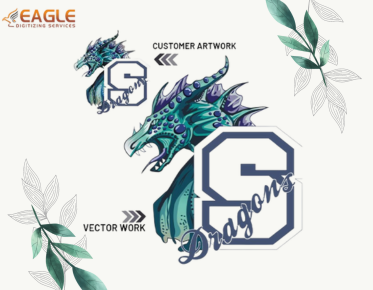Understanding Embroidery Digitizing: Process and Techniques
Embroidery digitizing is a fascinating process that transforms artwork into a digital file that embroidery machines can read. This digital file guides the machine on how to stitch the design onto fabric, ensuring precision and consistency. The process involves several steps and requires specialized software and skills. For those interested in exploring the intricacies of embroidery digitizing, Eagle Digitizing offers a wealth of resources and services to get started.
What is Embroidery Digitizing?
Embroidery digitizing is the art of converting artwork into a digital format that an embroidery machine can understand. This involves using embroidery digitizing software to create a file that contains the instructions for the machine to follow. The file specifies the stitch type, direction, and color changes needed to replicate the design on fabric. This process is crucial for producing high-quality embroidered products, as it ensures that the design is accurately represented.
The Embroidery Digitizing Process
Step 1: Preparing the Artwork
The first step in embroidery digitizing is preparing the artwork. This involves cleaning up the image and ensuring it is in a suitable format for digitizing. The artwork may need to be simplified or adjusted to ensure it can be effectively embroidered. This step is crucial as it sets the foundation for the entire digitizing process.
Step 2: Choosing the Right Software
Choosing the right embroidery digitizing software is essential for successful digitizing. There are various software options available, each with its own features and capabilities. The software allows the digitizer to create a digital file that the embroidery machine can read. It provides tools for setting stitch types, directions, and densities, which are critical for achieving the desired embroidery effect.
Step 3: Digitizing the Design
Once the artwork is prepared and the software is selected, the next step is to digitize the design. This involves creating a digital file that contains all the necessary instructions for the embroidery machine. The digitizer must decide on the stitch types, directions, and densities to use, as well as the sequence of stitching. This step requires a good understanding of both the software and the embroidery process to ensure the final product meets expectations.
Step 4: Testing and Adjustments
After the design is digitized, it is essential to test it on the embroidery machine. This allows the digitizer to see how the design translates onto fabric and make any necessary adjustments. Testing is a critical step in the process, as it ensures that the final product is of high quality and meets the desired specifications.
Techniques and Tips for Successful Embroidery Digitizing
Successful embroidery digitizing requires a combination of technical skills and artistic flair. Here are some tips to help achieve the best results:
- Understand the Fabric: Different fabrics require different approaches. Understanding the properties of the fabric you are working with is crucial for choosing the right stitch types and densities.
- Use the Right Stitch Types: There are various stitch types available, each suited for different parts of the design. Knowing when to use each type is key to achieving the desired effect.
- Pay Attention to Detail: Small details can make a big difference in the final product. Paying attention to the finer points of the design can elevate the quality of the embroidery.
Future Trends in Embroidery Digitizing
As technology continues to advance, the field of embroidery digitizing is also evolving. New software and tools are being developed to make the process more efficient and accessible. Additionally, there is a growing trend towards customization and personalization in embroidery, which is driving innovation in digitizing techniques. For those looking to stay ahead in the industry, keeping up with these trends is essential.
For those interested in professional embroidery digitizing services, Eagle Digitizing excels in providing high-quality solutions, ensuring every design is crafted with unmatched precision. Whether you're a hobbyist or a professional, understanding the intricacies of embroidery digitization can open up a world of creative possibilities.



